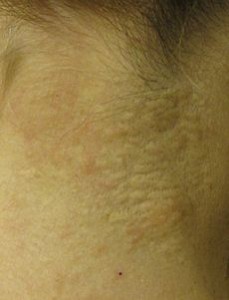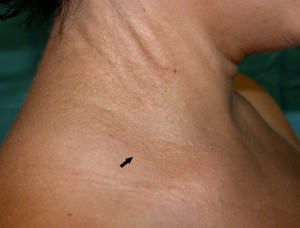Pseudoxanthoma Elasticum Definition
Page Contents
- 1 Pseudoxanthoma Elasticum Definition
- 2 Pseudoxanthoma Elasticum Incidence
- 3 Pseudoxanthoma Elasticum Causes
- 4 Pseudoxanthoma Elasticum Genetics
- 5 Pseudoxanthoma Elasticum Inheritance
- 6 Pseudoxanthoma Elasticum Pathophysiology
- 7 Pseudoxanthoma Elasticum Symptoms
- 8 Pseudoxanthoma Elasticum Diagnosis
- 9 Pseudoxanthoma Elasticum Differential Diagnosis
- 10 Pseudoxanthoma Elasticum Treatment and Management
- 11 Pseudoxanthoma Elasticum Prognosis
- 12 Pseudoxanthoma Elasticum Complications
- 13 Pseudoxanthoma Elasticum Prevention
- 14 Pseudoxanthoma Elasticum and Pregnancy
- 15 Pseudoxanthoma Elasticum Support Groups
- 16 Pseudoxanthoma Elasticum Pictures
Pseudoxanthoma Elasticum (PXE), also known as Grönblad–Strandberg syndrome, is a kind of progressive disorder characterized by mineralization in the elastic fibers of an individual. Mineralization denotes the accumulation of various minerals including calcium within the elastic fibers. The elastic fibers are an important part of the connective tissue, which provides flexibility and strength to all the structures in the human body.
Mineralization can be harmful for the elastic fibers in the eyes, skin and blood vessels. In some cases, other areas like the digestive tract may also get affected by this condition.
Pseudoxanthoma Elasticum Incidence
According to statistics, 1 out of every 70,000 to 100,000 individuals around the world is likely to develop the serious symptoms of this genetic disorder. The onset of the symptoms may occur in both children and adults. It can affect all races alike. However, women are more likely to have the disorder as compared to men.
Pseudoxanthoma Elasticum Causes
Around 80% of all cases of PXE are caused by mutation in the gene called ABCC6. All types of mutations in almost all regions of the ABCC6 gene have been properly described. The various mutation types that can lead to the disorder include:
- Nonsense
- Missense
- Insertion
- Splice alteration
- Large deletion and
- Small deletion
However, the nonsense and missense mutations have been found to be responsible for PXE in most instances.
Pseudoxanthoma Elasticum Genetics
Not much is known about the exact functions of the ABCC6 gene. However, it is known to provide and control the signal for making a certain protein known as the multidrug resistance-associated protein 6 or MRP6 (it is also referred to as ABCC6 protein). MRP6 protein is principally found in the cells of the liver and kidney.
Researchers have found strong genetic association of this disease with ABCC6 gene mutations, which codes for MRP6 protein. The MRP6 protein is a form of membrane transporter belonging to the family of large ATP-binding cassette transporter. It is believed to transfer certain substances through the membranes of the cells which affect the PXE course. However, the exact mechanism followed by this protein to influence the course of the disease is still not known.
ABCC6 gene mutations result in a nonfunctional or absent MRP6 protein, which may disrupt the transportation of certain substances into blood for being distributed in various parts of the body. However, it is still unknown how the mutations in ABCC6 gene cause mineralization of the elastic fibers and lead to the main symptoms of PXE.
Pseudoxanthoma Elasticum Inheritance
PXE can be inherited in both the autosomal recessive and the autosomal dominant inheritance patterns. However, researchers have recently discovered that most cases of PXE are inherited in the autosomal recessive pattern in which a child has to inherit one copy of the abnormal gene from each parents in order to develop this condition. If both parents are unaffected carriers of the gene mutation, they each have 25% chances of passing it on to their child who will then have the symptoms of PXE because he or she has two copies of the defective gene.
Pseudoxanthoma Elasticum Pathophysiology
This condition is primarily characterized by mineralization and fragmentation of elastin-containing fibers in the connective tissues, but mainly in the midlaminar layer of Bruch’s membrane, dermis and midsized arteries. Recently, various studies have suggested that PXE is a kind of metabolic disease. It is hypothesized that the characteristic features of the condition arise as it prevents the vitamin K metabolites from reaching the peripheral tissues.
Pseudoxanthoma Elasticum Symptoms
Mineralization occurring in this disorder leads to various ocular, skin and cardiovascular system symptoms. Following are the chief signs of PXE:
Skin problems
These include the following:
- Lesions on the skin around the back of the neck, which are one of the earliest signs of the disease. These lesions first appear during the patient’s childhood; however, they are not generally noticed until the individual reaches adolescence. In some cases, the lesions do not appear until the patient reaches an old age (70 years or above).
- Small, yellowish papules, which develop on the skin in a reticular or linear pattern. Sometimes, the papules may coalesce and form plaques.
- Lesions occuring in different parts of the body, including the underarms, elbow joints, knees and groin area. They may also occur in the oral, rectal and vaginal mucosa.
- The skin lesions are generally symmetrical and may occur on the entire body. However, this is rare.
- With the progression of the disorder, the skin on the axillae, neck and groin generally turn wrinkled, soft, lax and hanging in folds.
- Acneiform lesions along with chronic granulomatous nodules may also occur.
- In some cases, some “oblique mental creases” (slanting grooves of chin) may also be present.
Ocular Symptoms
Patients generally develop one or more of the following eye symptoms:
- Angioid streaks of retina, which are one of the most important characteristic features of PXE. These are grayish to reddish-brown curvilinear bands that radiate from the optic disc. However, the presence of angioid streaks does not always mean that an individual is suffering from this genetic disease.
- Fibrovascular ingrowths inside the retina, which may result in retinal haemorrhage which is a serious symptom of the condition.
- Central vision loss, often experienced by patients.
- A subretinal net, which may be detected before the symptoms of retinal haemorrhage occur.
Cardiovascular System Symptoms
PXE can lead to various cardiovascular diseases. However, these symptoms generally do not occur until the condition reaches an advanced stage. The cardiovascular signs include:
- Much reduced peripheral pulses (usually).
- Renal artery disease, which may lead to hypertension.
- Coronary artery disease, which leads to conditions like myocardial infarction and angina.
- Mitral Valve Prolapse, which is another common disorder that occurs in PXE patients.
- Possible rise in intracranial pressure to a life-threatening intensity.
- Hematuria, which is often present in patients.
Other symptoms of the condition may include the following:
- Joint pain
- Rashes
- High blood pressure
- Fatigue
- Chest pain
- Diarrhea
Pseudoxanthoma Elasticum Diagnosis
It is generally diagnosed by dermatologists as the principal symptoms of PXE involve the skin. However, ophthalmologists, gastroenterologists and cardiologists are also consulted due to the widespread manifestations of the condition. Various tests are used for diagnosing the Grönblad-Strandberg syndrome. These include:
- Occult blood test for detecting gastrointestinal bleeding
- CBC (Complete Blood Count)
- Urinalysis
- Serum phosphate and serum calcium count, as these levels often increase due to PXE
- X-ray
- Echocardiogram
- Ophthalmic examination (for detecting signs of angioid streaks, retinopathy and retinal hemorrhages)
- Coronary angiography
- Endoscopy
- MRI (Magnetic Resonance Imaging)
Pseudoxanthoma Elasticum Differential Diagnosis
The differential diagnosis includes ensuring the absence of conditions that give rise to similar symptoms, such as:
- Elastosis Perforans Serpiginosum
- Cutis Laxa (Elastolysis)
- Marfan’s syndrome
- Sickle Cell Anemia
- Severe actinic neck damage
- Ehlers-Danlos Syndrome
- Buschke-Ollendorf Syndrome (Dermatofibrosis Lenticularis)
- Thalassemia, Beta
- Papillary Dermal Elastolysis
Pseudoxanthoma Elasticum Treatment and Management
It is not possible to cure this disorder completely, as no specific treatment option is available for it. However, it is possible to keep the symptoms in check by taking medications and following certain dietary restrictions. Lowering the amounts of calcium intake has been proven to be helpful in some cases.
Plastic surgery can be used for correcting the disorder in large skin areas. Photodynamic therapy and laser photocoagulation are useful for treating the abnormal blood vessel growth in the retina. In some instances, a Triamcinolone injection may be useful for the treatment.
Various antiangiogenic drugs, including ranibizumab (Lucentis) and bevacizumab (Avastin), can successfully treat PXE. These drugs work in the similar manner as they do for treating age-related macular degeneration. According to some physicians, PXE patients should avoid NSAIDS (nonsteroidal anti-inflammatory drugs) like ibuprofen and aspirin as they increase the risks of bleeding and hemorrhage.
Pseudoxanthoma Elasticum Prognosis
The prognosis of the disorder mainly depends on the degree of involvement of the extracutaneous organ and varies from one person to another. In the majority of cases, patients have a normal life expectancy. However, serious myocardial infarction, cerebral hemorrhage and acute GI hemorrhage due to PXE may cause death of an individual in some rare instances. PXE itself has a low mortality rate.
Pseudoxanthoma Elasticum Complications
Individuals with PXE may experience the following complications if they do not receive proper and timely treatment:
- Various heart disorders such as stroke
- Gastrointestinal and brain hemorrhage
- Fatal coronary occlusion
- Severe retinal hemorrhage
- Central vision loss
- Lung diseases
- Claudication
- Hypertension
- Angina
Pseudoxanthoma Elasticum Prevention
There is no known way to prevent this genetic disease. Couples with a family history of PXE should consider gene reviews and genetic testing to find out if they carry the abnormal gene. This makes it possible to take early action for preventing the advancement of the disorder in a child in cases where one or both parents are carriers of the abnormality.
Pseudoxanthoma Elasticum and Pregnancy
Studies show that PXE does not give rise to any additional complications in pregnant women. Most women suffering from the condition have regular delivery after normal pregnancy and labor. They do not experience any additional health problems during the postpartum period as well.
Pseudoxanthoma Elasticum Support Groups
Numerous forums and associations have been founded to provide facts and information to the patients and their families regarding the ways of keeping the condition in check. These support groups include:
National Association for Pseudoxanthoma Elasticum
8760 Manchester Road
St. Louis, Missouri 63144-2724
United States
Tel: (314)962-0100
Fax: (314)962-0100
Email: [email protected]
Website: http://www.pxenape.org/
NIH/National Eye Institute
31 Center Dr
MSC 2510
Bethesda, Maryland 20892-2510
USA
Tel: (301)496-5248
Fax: (301)402-1065
Email: [email protected]
Website: http://www.nei.nih.gov/
Coalition for Heritable Disorders of Connective Tissue
4301 Connecticut Avenue, NW, Suite 404
Washington, DC 20008
Fax: (202)966-8553
Tel: (800)778-7171
Email: [email protected]
Website: http://www.chdct.org
Pseudoxanthoma Elasticum Pictures
Check out a few images that show how PXE affects the appearance of the skin of a person.
Picture 1 – Pseudoxanthoma Elasticum
Picture 2 – Pseudoxanthoma Elasticum Image
Pseudoxanthoma Elasticum is a rare, but potentially severe hereditary disorder. It is not a life threatening condition although leaving it untreated may lead to various fatal complications. However, a patient can live a long and normal life with early treatment.
References:
http://ghr.nlm.nih.gov/condition/pseudoxanthoma-elasticum
http://emedicine.medscape.com/article/1074713-overview
http://www.medicinenet.com/pseudoxanthoma_elasticum/article.htm
http://www.patient.co.uk/doctor/Pseudoxanthoma-Elasticum.htm
http://www.bbc.co.uk/health/physical_health/conditions/pxe1.shtml


